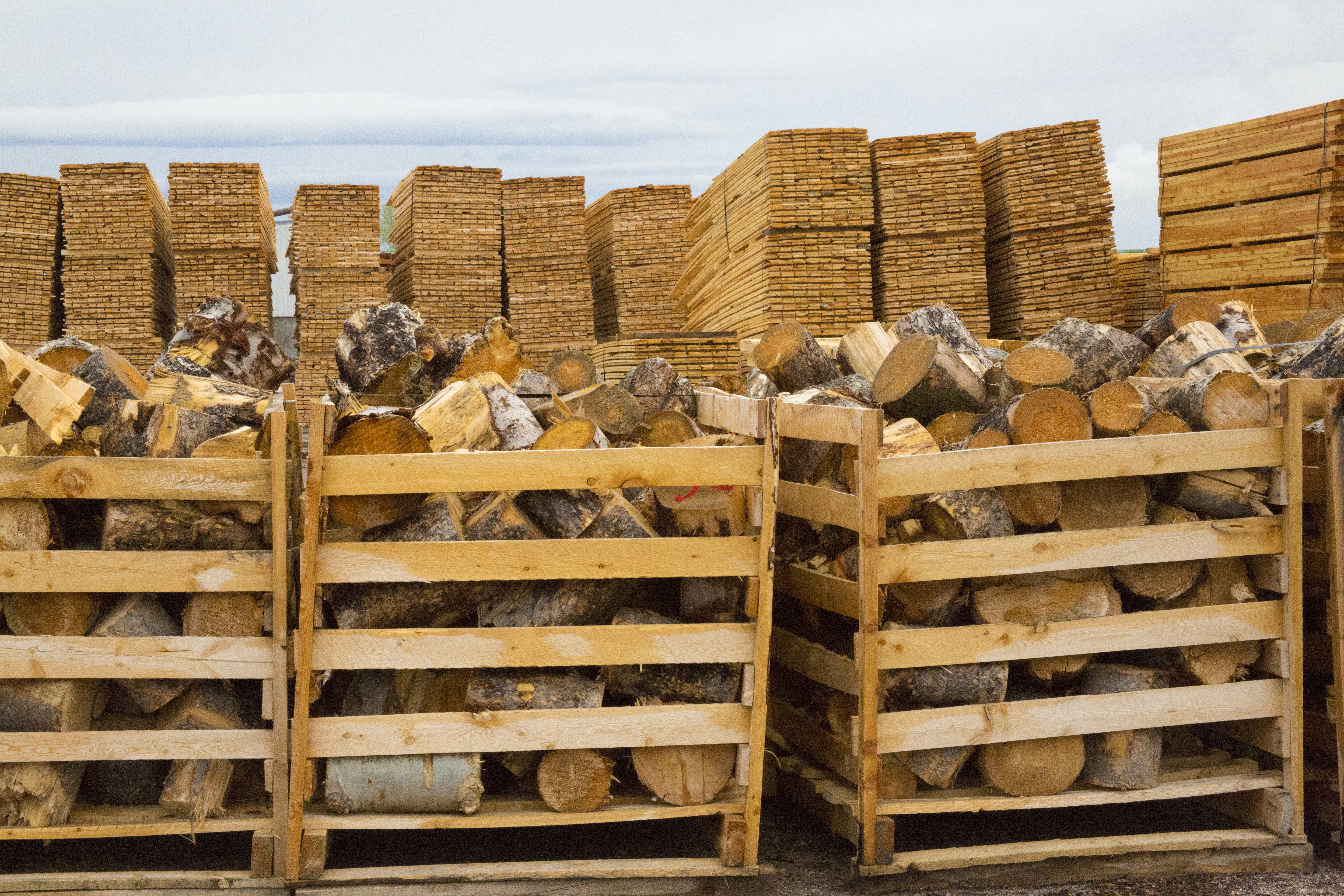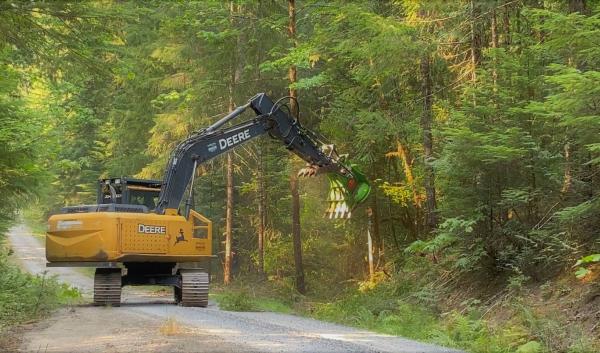Reading Time: 9 minutes

Forests in Idaho, Oregon, and Washington are vital economic, ecological, and social resources. They provide plant and animal habitat, generate timber, purify air and water, and support rural livelihoods and communities. However, climate change is likely to alter forests in the region, which could affect forest industries. Rising temperatures and more frequent wildfires, droughts, and other disturbances could influence where some tree species can grow and where they will continue to be productive. For instance, the range of ponderosa pine could increase at higher elevations in the Blue Mountains of eastern Oregon and Washington, and Douglas-fir could expand into higher elevations in the western Cascades. Some forests may even transition to grasslands and shrublands, particularly at lower elevations, eliminating timber production in those locations. Low- and mid-elevation dry coniferous forests, like those found on the east side of the Cascades, the Palouse Prairie-forest ecotone in Washington and Idaho, and drier Rocky Mountain regions of northern Idaho, are particularly vulnerable to increasing wildfire frequency and size. Compounding these challenges, tree growth rates and habitat at some locations may decline, which could affect economic benefits.
In response to these changes, the Sustainable Forestry Initiative (SFI) partnered with the USDA Northwest Climate Hub to identify key climate vulnerabilities in industrial forestry and develop adaptation strategies to manage climate risks and build resilience. The goals of this partnership included 1) identifying climate change risks to SFI-certified organizations; 2) developing a regional risk assessment; 3) identifying potential adaptation actions to address climate change impacts; and 4) in some cases, providing mitigation opportunities. These goals were achieved with a workshop that included SFI members from Idaho, Oregon, Washington, Montana, and California.
Key climate vulnerabilities of industrial forestry practices in Idaho, Oregon, and Washington
The effects of climate change differ across Idaho, Oregon, and Washington, with some effects influencing forest ecosystems and forestry operations more than others. Generally, the area west of the Cascade Range has a maritime climate with mild seasonal temperatures and wet winters. The Cascades act as a moisture barrier to the east side of the mountains, where the climate is drier, with colder winters and hotter summers. Considering regional climate, members of SFI and the Northwest Climate Hub identified key climate vulnerabilities for east- and west-side forests.
- Higher Temperatures – Temperatures in the Northwest are project to increase 4.5 to 5.6°F by the 2080s, depending on global greenhouse gas emissions, with the greatest warming expected to occur during summer.
- Warmer Winters – The winter season will be shorter and warmer. There will be fewer chilling hours, which can affect the bud break of trees. At low to mid elevations, there will be less precipitation falling as snow, as well as reduced snow cover and depth.
- Changing Precipitation – Annual precipitation is projected to increase over the course of the 21st century. Seasonally, precipitation will likely increase in the winter, and summer precipitation may decrease. Intense precipitation events will likely become more frequent. The timing and amount of stream flow is expected to change, with higher peak flows in winter and lower low-flows in summer.
- Extreme Events – Heavy rainfall events are expected to become more severe, with a greater length of time between precipitation events. In some areas, heavy rainfall can lead to flooding and/or landslides. Extreme-heat events are also likely to become more frequent. Early warming in spring followed by frost can damage tree buds.
- Altered soil moisture and increased drought risk – Warmer temperatures and changing precipitation will interact to change soil moisture patterns throughout the year, with the potential for both wetter and drier conditions depending on the location and season. Forest vegetation will likely experience more moisture deficit and drought stress during the summer, potentially reducing tree growth and forest productivity.
- Increased wildfire area burned – Higher temperatures, lower summer precipitation, and drier conditions will lead to longer fire seasons and increased area burned.
- Increase in insect pests and forest pathogens – Certain insect pests and pathogens (e.g., mountain pine beetle) will increase in occurrence or become more damaging in a warmer climate. Though there is uncertainty about how climate change will affect forest pathogens, tracking this relationship over time will be important to forest industries.
- Increased invasive plant species – With increased disturbance, there will be more opportunities for the establishment of invasive plants (e.g., cheatgrass, ventenata).
- Changes in forest composition – Many tree species will face increasing stress across the region, particularly those species that are not tolerant of drought and are at the southern edge of their range. Conditions affecting tree regeneration and recruitment will change.
- Increased costs for forest operators – Road damage and erosion from heavy rainfall, and regeneration failures from seedling mortality will contribute to increased costs.
Adaptation strategies that address climate change risks to forest industries

Though timber-based economies face heightened economic risks from climate change, forest managers have valuable local knowledge that can be used to adapt to challenges and, in some cases, reduce the effects of climate change. Recognizing this, SFI and the USDA Northwest Climate Hub worked with representatives from the timber industry to identify adaptation and mitigation actions to address climate change. Importantly, climate-informed management does not require a wholesale change in management. In most cases, it consists of using and modifying best practices as needed, and reprioritizing the type and location of some practices. The following sections describe climate vulnerabilities and offer possible adaptations for industrial forestry practices.
Impact: Extreme events (e.g., floods and wildfires) could increase road washouts and maintenance costs, potentially limiting access to forest resources.
Possible adaptation actions:
- Increase culvert sizes when constructing roads or replacing culverts
- Design road systems to handle runoff and reduce erosion risk
- Increase monitoring of road conditions after extreme precipitation events
- Take actions to secure or stabilize unstable slopes
- Integrate flexibility in harvest plans for salvage
- Develop response plans for large disturbance events (e.g., wildfires)
- Install fuel breaks in high-risk areas around high-value stands and infrastructure
- Incorporate emergency alternate route plans
Impact: Temperature changes could cause bud damage in commercially important timber species.
Possible response:
- Maintain or create stand genotypic and species diversity
Impacts: Increases in fire area burned could cause reductions in commercially important timber and economic losses for operations. Increased wildfire could also lead to a loss of productivity and increased costs to operations.
Possible responses:
- Create post-fire salvage logging plans
- Conduct hazardous fuels reduction and increase use of prescribed fire to lower wildfire risk in eastside forests
- Increase installation of strategic fuel breaks
- Increase fire readiness
- Implement logger training for initial attack and increase support for loggers on required RT130 training (wildland fire and support training)
- Increase public education and outreach
- Control public access during periods of high fire risk to reduce human-caused ignitions
- Increase road maintenance on public land for fire control access
- Support management efforts (Good Neighbor Authority, fuel treatments, and others) for fire risk reduction on federal lands
- Support interagency cooperation on fire control
- Support increased use of technology in detection and rapid response
- Develop and support alternative markets (e.g., biochar)
- Increase post-fire regeneration readiness (increase nursery capacity)
Impacts: Higher temperatures could decrease the growth rates of certain tree species and increase drought stress.
Possible responses:
- Plant alternative genotypes or species that are resilient to increased temperatures
- Increase stand structural and genetic diversity
- Consider planting at lower densities to increase drought resilience, depending on site conditions
- Monitor and share best practices related to local effects of increased temperatures on species
Altered soil moisture
Impacts: Lower soil moisture in spring and summer could lead to increased tree mortality, reduced growth rates, and reduced reforestation success.
Possible responses:
- Consider design of clearcuts to increase shaded areas (smaller/patches)
- Retain slash where appropriate
- Create adaptive plans to alter timing of plantings to maximize survival
- Increase use of drought-tolerant species
- Increase thinning (frequency and intensity) to reduce tree density, drought stress, and mortality
- Increase site-specific herbicide applications to facilitate vegetation control
- Reduce competing brush
- Monitor effects of soil moisture and share lessons learned with other organizations
- Increase meadow restoration
Impacts: Increases in insect pests and forest pathogens could reduce growth rates and forestland productivity, increase tree mortality, and increase costs to operations.
Possible responses:
- Increase monitoring to inform early detection and rapid response for pests and pathogens
- Create adaptive salvage logging plans in response to pest and pathogen presence
- Increase thinning (frequency and intensity) to maintain stand vigor and reduce density
- Consider planting alternate species that are more resistant to pests and pathogens
- Prune, when needed, to prevent pathogens
- Implement harvest-timing restrictions to slow spread of pathogens
- Implement Integrated Pest Management practices
Impacts: Changes in tree species and genotypes that grow productively in a particular location can lead to reforestation challenges and reduce the growth of species on the edge of their range (e.g., Douglas-fir in southwest Oregon).
Possible responses:
- Implement silvicultural alternatives
- maximize species diversity
- alter genotypes to match climate
- maintain pockets of advanced residual regeneration
- create adaptive plans to plant alternative species
- Support research and share best practices
- Strategically collect seeds and cones to match genetics to local climate
- Develop logging strategies and training for protecting regeneration of a variety of ages and species
Impacts: Invasive species can reduce growth rates and the productivity of forestland while increasing tree mortality and costs to operations.
Possible responses:
- Implement early detection and rapid response
- Increase monitoring for invasives after fire and harvest
- Collaborate on best practices across landscapes, watersheds, and cooperatives
- Consider aggressive treatment plans when infestation occurs
- Plan future operations for optimal times to reduce spread
Impacts: Higher rainfall intensity can increase the likelihood and costs of road washouts, potentially limiting access to harvestable timber.
Possible responses:
- Implement best management practices to protect riparian areas, channel migration zones, and roads
- Monitor local precipitation and road conditions for changes or newly developed springs
- Increase culvert size
- Adjust water diversions
Maintaining healthy forests for the future
The future health of forests in Idaho, Oregon, and Washington hinges on our ability to adapt to climate change. By working together, the forest industry, researchers, and communities can implement innovative strategies, including some of those described above, to ensure the continued health and productivity of forests. Sustainable forest management that considers climate change will be crucial for maintaining a robust timber industry, protecting ecosystems, and supporting rural livelihoods in the Northwest.
See the Fact SheetClimate Change Adaptation Library for the Western United States: Intended to inform sustainable management of natural resources, reduce the negative effects of climate change, and transition ecosystems to a warmer climate. It can also help integrate climate change in natural resource management, planning, and business operations.
Prescribed Fire in the Northwest: Describes advantages and disadvantages of prescribed fire in the Northwest and the process of conducting a prescribed fire.
Climate Resilience Guide for Small Forest Landowners in Western and Eastern Washington: Provides information, resources, and management actions to help small forest landowners adapt to a changing climate.
The Seedlot Selection Tool: Assists land managers in considering climate change while planning reforestation and restoration efforts.
Climate Risk Management Practices: Provides a synthesis of key climate change sensitivities and risk management practices for forest vegetation, non-forest vegetation, water and infrastructure, fisheries and fish habitat, wetlands and riparian areas, wildlife, and recreation for the Western US.
Climate Change and Wildfire in Idaho, Oregon, and Washington: Discusses the risk of large, frequent, and severe wildfires in Idaho, Oregon, and Washington. These fires are associated with warm and dry conditions that are likely to increase with climate change.
Climate Toolbox: Shows observed and future projected climate information, including future stream flows in comparison to historical stream flows, for much of the Northwest.
Forest Management Handbook for Small-Parcel Landowners (Sierra Nevada and southern Cascade Ridge): Written specifically for small-parcel (10-100 acre) landowners in the Sierra Nevada and southern Cascade Region. It takes landowners through a step-by-step guide to creating a plan to cope with many of the changes brought by climate change.
-
Northwest Forests and Woodlands
Northwest forests and woodlands are valuable resources vulnerable to climate change.
-
Mechanical Fuel Treatments for Climate Resilience in…
Mechanical fuel treatments are a proactive reduction of overgrown forests that can help reduce risks of wildfire.
-
A Climate Resilience Guide for Small Forest Landowners
This guide provides information, resources, and management actions to help small forest landowners adapt to a changing climate.




